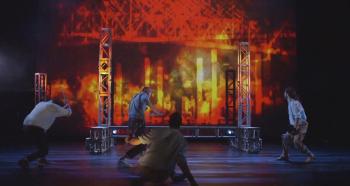Image Caption
Summary
Local Journalism Initiative Reporter
Windspeaker.com
The Ontario premiere of A’nó:wara Dance Theatre’s production of Sky Dancers is set to take the stage May 20 to May 23 at Fleck Dance Theatre in Toronto.
Sky Dancers is a theatrical dance performance about the Quebec Bridge Disaster of 1907. It is part of Harbourfront Centre's contemporary dance series Torque.
In 1907 members of the Kahnawake First Nation were working alongside other iron workers on the construction of the Quebec Bridge. It was to be the longest cantilever bridge in the world.
On Aug. 29, 1907, the shift change whistle had just blown when the workers heard a piercing noise and the bridge began to collapse. Some of the workers made it to safety, but almost 80 men did not.
Of those, 33 Kahnawake men died that day leaving behind their wives, children and families.
One of the men who died was Barbara Kaneratonni Diabo’s great grandfather Louis D’Aillebous. His body was never recovered.
“These are real people. These are real families. It’s so important to understand that and not just think of it as a story you read in a book,” said Diabo, creator, choreographer and director of the show.
“It is so important to truly understand the impact it had on us and the resilience that our people have from living these things and how we pulled together and got through it.”
After five years working on the production, she said she’s glad to finally be able to bring it in front of an audience.
“In Sky Dancers, I consider it a real honouring of the men who died that day, their families, the community and the descendants. Every time we go on stage, we remind ourselves that we are truly doing this to honour those people and it is not just to perform a show.”
Diabo put a lot of effort into researching the events of that day, but also into what happened to the community following the disaster.
She heard stories from knowledge keepers and Elders about how the women grieved, how during that grief period they had to retrieve the bodies of their husbands, how some women were pushed to send their children to residential schools as they were told they could no longer take care of their families without their husbands.
“It was like a double tragedy. They lost their husbands and their children. So, I wanted to bring that to light because many people don’t think about that,” she said.
She also captures the Mohawk culture of Kahnawake First Nation in the performance by showcasing traditional dances, clothing and the people of the community through a variety of dance styles, including contemporary, lyrical, breakdancing and hoop.
The backdrop consists of a stunning video projection and set design, created by Andy Moro.
Costumes for the show were created by Jeff Chief. Michael Diabo created the music.
While preparing and training for the production, Kaneratonni wanted to ensure everyone involved in the show had a strong understanding about the impact the disaster had on the people, but also understood the culture they were representing each time they went on stage.
“For me, it was really important that they, all the dancers, really understood the world that we are honouring,” she explained. “It was an interesting experience in trying to find real ways to bridge gaps and educate each other about this world. I do a really kind of a global approach to my rehearsal process in training my dancers. I start every day with a talking circle and then we have a bit of a Mohawk language lesson.”
Diabo also took all of the dancers to meet Elders from the community and to visit the bridge memorial.
She said she has been studying dance all of her life and feels so honoured to be able to translate this story on stage through dance.
“For me dance is like a vocabulary. It is a way of expressing things without words. Sometimes you can say (more through dance) when words aren’t enough.”
Local Journalism Initiative Reporters are supported by a financial contribution made by the Government of Canada.

